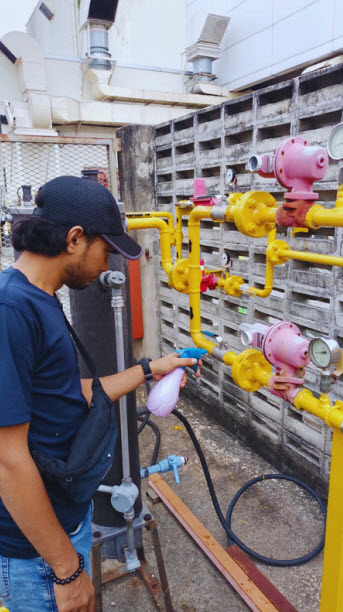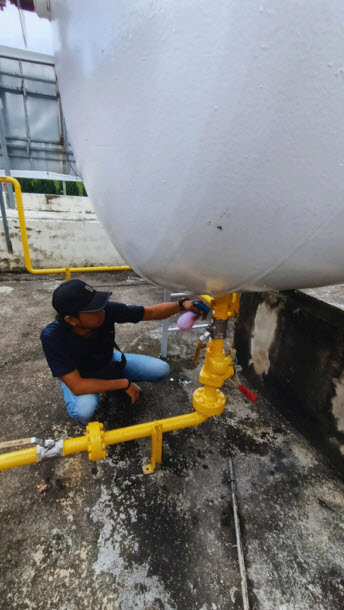
Preventive Maintenance
Our specialized in house Engineering team carrying out requalification works which includes a full inspection report and licensing assistance.
Preventive maintenance for LPG systems is an ongoing process that requires thorough inspections, testing, and replacement of parts as necessary. By implementing a detailed preventive maintenance program, you can significantly reduce the risks associated with LPG use and ensure smooth, efficient operation of your LPG systems.
Preventive maintenance for LPG systems:
Inspection and Testing of Storage Tanks
- Check for Leaks: Regularly inspect LPG storage tanks for any signs of leakage, rust, corrosion, or damage. This can be done visually, and using soapy water to check for leaks in valves, connections, and pipe joints.
- Pressure Testing: Periodic pressure tests ensure that the tank and associated pipelines can withstand the operational pressures and do not leak.
- Tank Venting and Relief Valve Inspection: Ensure that the pressure relief valve is functioning properly and is not blocked or obstructed. This valve prevents over-pressurization in case of a system fault or if the LPG inside the tank heats up.
- Calibration of Gauges: Check and calibrate tank level gauges and pressure gauges to ensure accurate readings.
Piping and Valve Maintenance
- Inspect Piping for Corrosion and Integrity: LPG pipes should be checked for corrosion, cracks, or other forms of damage. Ensure that there are no signs of wear and tear, and replace any damaged pipes immediately.
- Valve Inspection: All shut-off valves, safety valves, and regulators should be tested periodically to ensure they open and close properly without any leaks. It’s important to replace any faulty valves that do not maintain the required sealing pressure.
- Strainer Cleaning: Many LPG systems include strainers or filters in the supply lines to catch debris. These should be cleaned regularly to prevent blockages.
Regulator and Pressure Control Maintenance
- Inspect Regulators: LPG regulators are critical in controlling the gas pressure. They should be inspected and calibrated regularly to ensure the gas pressure remains within safe operating levels.
- Replace Seals and Diaphragms: Over time, the internal seals or diaphragms of regulators may wear out, leading to leakage or incorrect pressure regulation. These components should be replaced based on manufacturer recommendations.
Safety Systems and Alarm Checks
- Inspect Safety Devices: LPG systems are equipped with various safety devices like pressure relief valves, flame arresters, and excess flow valves. These need to be checked to ensure they are in good working condition.
- Gas Detectors: In areas where LPG is stored or used, gas detectors should be installed to detect any possible leakage. These detectors should be tested periodically to ensure they can function correctly in case of a gas leak.
- Emergency Shutdown System (ESD): If an emergency arises, the ESD system should be activated to stop the flow of gas. Regular testing and maintenance of the ESD system ensure that it will work as intended during an emergency.
Burner and Appliance Maintenance
- Clean Burners: LPG burners should be cleaned regularly to prevent blockages, ensuring efficient combustion. Blocked burners can lead to incomplete combustion, resulting in carbon monoxide production and potential fire hazards.
- Check Flame Characteristics: Ensure that burners and appliances maintain a steady and proper flame. Abnormal flames can indicate issues such as low pressure, incorrect air-fuel mixture, or blockages.
- Inspect Burnt Components: Regularly inspect all components of the appliances (e.g., stoves, heaters, etc.) for wear and tear. Replace any faulty parts to maintain optimal performance.
General Cleanliness and Housekeeping
- Clean LPG System Components: Regular cleaning of tanks, pipelines, and equipment ensures that dirt, oil, or other debris do not interfere with the functioning of the system.
- Remove Obstructions: Ensure that no debris or flammable materials are stored near LPG tanks or pipelines, which could pose a fire hazard in case of a leak.
- Visual Inspections: Carry out routine visual inspections to identify any potential risks, such as faulty wiring, improper installations, or damaged protective covers.
Documentation and Compliance with Regulations
- Record Maintenance Activities: Keep a detailed log of all preventive maintenance tasks, including inspections, tests, repairs, and replacements. This is crucial for regulatory compliance and safety audits.
- Regulatory Inspections: Ensure that all inspections and maintenance activities meet local regulations and standards for LPG systems. This might include periodic external inspections by safety authorities or insurance companies.
- Employee Training: Ensure that staff working with LPG systems are properly trained in safety procedures, maintenance tasks, and emergency response protocols.
Pressure Relief and Venting Systems
- Pressure Relief Valve Testing: Pressure relief valves (PRVs) must be regularly tested to make sure they function at the correct pressure and will release gas if over-pressurization occurs.
- Venting Systems: The venting system, which allows the release of excess pressure, should be inspected for blockages or any signs of failure. Clear and unobstructed vents are essential to ensure safe operation.
Leak Detection and Response
- Leak Detection Systems: Automated leak detection systems should be employed in high-risk areas. These systems should be tested and calibrated to ensure they are functional.
- Safety Training: Staff should undergo regular safety training to familiarize themselves with procedures in case of an actual gas leak.
Routine Calibration and Adjustment
- Flow Meters Calibration: Flow meters used to measure the amount of gas being supplied to different sections of the system should be calibrated periodically.
- Burner and Pressure Calibration: Calibrate the pressure and flow settings of appliances and burners to ensure they are operating at the correct efficiency and safety levels.
Benefits of Preventive Maintenance in LPG Systems:
Enhanced Safety
Extended Equipment Lifespan
Improved Efficiency
Compliance with Legal and Insurance Requirements





